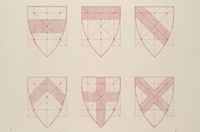Ruskin's revision to the Rudimentary series (1878)
Unpublished manuscript catalogue for proposed re-organisation of the Rudimentary series.

Ruskin's Catalogues: 1 object
Show search helpAlpine Peaks: The Jungfrau, Eiger and Others John Ruskin
-
Ruskin text
118.Rapid studies of effects from the Faul-horn. I had only one bit of paper and packed the mountains all over it; but the Schreck-horn and Finsteraarhorn are all right as they first appear behind the brown rocks of the Faul-horn. Then, the summit of the Schreck horn becoming clear, I sketched it above the Finsteraarhorn. Presently, the Finsteraarhorn throwing off its clouds, I saw I had got it too steep and drew it again below itself. Farther to the right the Eiger and Jung-frau had to be packed in at the left-hand bottom corner, and a final study of the quite clear Schreck horn filled up what was left. These memoranda recall to me a most lovely scene, and I think the method of their execution is the most serviceable R. that can be adopted for such rapid work.
-
Details
- Artist/maker
-
John Ruskin (1819 - 1900)
- Object type
- drawing
- Material and technique
- watercolour and bodycolour over graphite on paper
- Dimensions
- 168 x 252 mm
- Associated place
-
- Europe › Switzerland › Bernese Alps › Eiger › Eiger (subject)
- Europe › Switzerland › Bernese Alps › Finsteraarhorn › Finsteraarhorn (subject)
- Europe › Switzerland › Bernese Alps › Jungfrau › Jungfrau (subject)
- Europe › Switzerland › Bernese Alps › Faulhorn › Faulhorn (subject)
- Inscription
- Recto:
above the left-hand of the two upper peaks: b
below the same peak: Mettenberg
just above the horizontal join, left: Schreckhorn [the first 'c' added later]
just above the horizontal join, right of centre: F.Aarhorn
just above the horizontal join, right: Eiger
on the lower right-hand sheet, towards top, left: F. Aarhorn
bottom left: Eiger
bottom, left of centre: Jungfrau
bottom, towards right: Schreckhorn
- Provenance
-
John Ruskin; recorded in the Ruskin Drawing School in 1878, but never presented to the School; removed from the Drawing School by John Ruskin, 1887; W.A. Cadbury?; presented by an anonymous donor to B
- No. of items
- 1
- Accession no.
- BIRMG.1907P145
-
Subject terms allocated by curators:
Subjects
-
References in which this object is cited include:
References
Taylor, Gerald, ‘John Ruskin: A Catalogue of Drawings by John Ruskin in the Ashmolean Museum, Oxford’, 7 fascicles, 1998, Oxford, Ashmolean Museum, no. 345
[City of Birmingham Museum and Art Gallery], City of Birmingham Museum and Art Gallery: Catalogue of the Collection of Drawings and Studies ... Exhibited in the Upper Galleries of the Museum, Birmingham (Birmingham: City of Birmingham Museum and Art Gallery, 1913), no. 546, p. 73
Ruskin, John, ‘Rudimentary Series 1878’, 1878, Oxford, Oxford University Archives, cat. Rudimentary no. 118
Location
-
- Birmingham Museums and Art Gallery
Ruskin's Catalogues
-
Ruskin's revision to the Rudimentary series (1878)
118.Rapid studies of effects from the Faul-horn. I had only one bit of paper and packed the mountains all over it; but the Schreck-horn and Finsteraarhorn are all right as they first appear behind the brown rocks of the Faul-horn. Then, the summit of the Schreck horn becoming clear, I sketched it above the Finsteraarhorn. Presently, the Finsteraarhorn throwing off its clouds, I saw I had got it too steep and drew it again below itself. Farther to the right the Eiger and Jung-frau had to be packed in at the left-hand bottom corner, and a final study of the quite clear Schreck horn filled up what was left. These memoranda recall to me a most lovely scene, and I think the method of their execution is the most serviceable R. that can be adopted for such rapid work.





